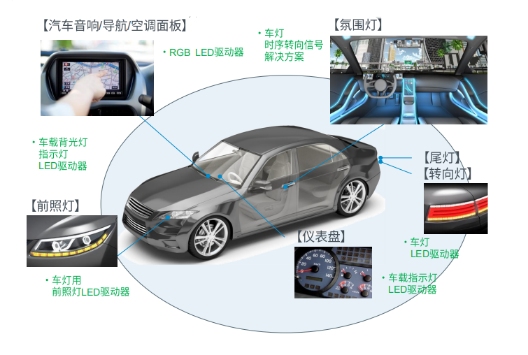Toshiba Electronic Devices & Storage Corporation Unveils Bluetooth® Low Energy SoC with Long-distance Communication and Low Power Consumption
时间:2018-07-11 11:55来源:东芝半导体&存储产品
摘要:ToshibaElectronicDevices&StorageCorporation(“Toshiba”)todayunveiledaBluetooth®lowenergySystem-on-Chip(SoC)forIoTdevicescompliantwithVersion50standard
The SoC realized the highest link budget with low power consumption
TOKYO--Toshiba Electronic Devices & Storage Corporation (“Toshiba”) today unveiled a Bluetooth® low energy System-on-Chip (SoC) for IoT devices compliant with Version 5.0 standard, that realizes a 113dB link budget[1], the highest[2] yet achieved, and a high transmission power efficiency of 22%. These characteristics push the SoC’s long-distance communication to 600m, 4.6 times that of its predecessor [3] while cutting power consumption to about 70% that of standard products that support the same communication distance. Toshiba presented the technology at VLSI Circuits Symposium 2018, the international conference on semiconductor devices held in Honolulu, Hawaii on June 19.Continued advances in IoT technology is bringing new capabilities to fields as diverse as wearable devices and medical equipment, and advanced functionality is taking more and more computing to the edge, particularly into industrial systems. Progress here is based on developing advanced functions. For instance wireless communication ICs must be able to deliver long-distance communications without consuming too much power. This is the need Toshiba addresses with its new SoC.
Bluetooth® low energy is the de facto standard for wireless communications. However, typical Bluetooth® low energy SoCs generate harmonic emission when output power increases, and can potentially violate Federal Communications Comission regulations. Additionally suppression of harmonic emission and efficiency is a trade-off that has made it difficult to achieve both long-distance communication and low power consumption.
Toshiba has developed two technologies for the power amplifiers of Bluetooth® low energy SoCs that minimizes the problem.
First, a new technology to enhance suppression of harmonic emission. This is usually done by symmetry feedback[4] that extends to the drivers. However, this does not suppress harmonic emission generated in the final output from the power amplifiers. If symmetry feedback is applied, including in the final stage, it only results in further transient harmonic emission. Toshiba minimized this problem by adding a “presetter”[5] that suppresses transient harmonic emission.
Secondly, Toshiba improved efficiency in the output stage of power amplifiers. This contains two switch transistors. When both are turned on, a large “through-current” flows, and power consumption increases. Toshiba developed a structure to separately control these switches, successfully suppressing through-current.
In combination, these technologies extend the communication range while suppressing harmonic emission and reducing power consumption.
Toshiba started to ship samples of Bluetooth® low energy SoCs compliance with Version 5.0 standard with the new technologies in January this year, and plans to start mass production in September. Toshiba continues to promote R&D in technologies for wireless communication ICs, and to contribute advances in IoT devices.
Notes
[1] Link budget refers to the difference between transmission power (in dBm) and the sensitivity of the receiver (in dBm). The larger the link budget means the further the communication.
[2] In Bluetooth® low energy SoCs compliant with version 5.0. As of January, 2018. Toshiba Electronic Devices & Storage Corporation
[3] TC35678, Toshiba Electronic Devices & Storage Corporation’s earlier product
[4] Symmetry feedback senses the asymmetry of waveform and then adjusts them to achieve symmetry.
[5] A presetter circuit in power amplifiers is set to a predicted convergence before symmetry feedback starts.
* The Bluetooth® word mark and logos are registered trademarks owned by the Bluetooth SIG, Inc.
Comparison of conventional technology and proposed technology

Communication distance vs link budget

Mixed Signal IC Sales and Marketing Department
Sales and Marketing Group II
Tel: +81-44-548-2876
https://toshiba.semicon-storage.com/ap-en/contact.html
免责声明:本文若是转载新闻稿,转载此文目的是在于传递更多的信息,版权归原作者所有。文章所用文字、图片、视频等素材如涉及作品版权问题,请联系本网编辑予以删除。
我要投稿
近期活动
- 安森美汽车&能源基础设施白皮书下载活动时间:2024年04月01日 - 2024年10月31日[立即参与]
- 2023年安森美(onsemi)在线答题活动时间:2023年09月01日 - 2023年09月30日[查看回顾]
- 2023年安森美(onsemi)在线答题活动时间:2023年08月01日 - 2023年08月31日[查看回顾]
- 【在线答题活动】PI 智能家居热门产品,带您领略科技智慧家庭时间:2023年06月15日 - 2023年07月15日[查看回顾]
- 2023年安森美(onsemi)在线答题活动时间:2023年06月01日 - 2023年06月30日[查看回顾]
分类排行榜
- 汽车电子电源行业可靠性要求,你了解多少?
- 内置可编程模拟功能的新型 Renesas Synergy™ 低功耗 S1JA 微控制器
- Vishay 推出高集成度且符合 IrDA® 标准的红外收发器模块
- ROHM 发布全新车载升降压电源芯片组
- 艾迈斯半导体推出行业超薄的接近/颜色传感器模块,助力实现无边框智能手机设计
- 艾迈斯半导体与 Qualcomm Technologies 集中工程优势开发适用于手机 3D 应用的主动式立体视觉解决方案
- 维谛技术(Vertiv)同时亮相南北两大高端峰会,精彩亮点不容错过
- 缤特力推出全新商务系列耳机 助力解决开放式办公的噪音难题
- CISSOID 和泰科天润(GPT)达成战略合作协议,携手推动碳化硅功率器件的广泛应用
- 瑞萨电子推出 R-Car E3 SoC,为汽车大显示屏仪表盘带来高端3D 图形处理性能
编辑推荐

小型化和稳定性如何兼得?ROHM 推出超小型高输出线性 LED 驱动器 IC,为插座型 LED 驱动 IC 装上一颗强有力的 “心脏”
众所周知,LED的驱动IC担负着在输入电压不稳定的情况下,为LED提供恒定的电流,并控制恒定(可调)亮度的作用。无论是室内照明,还是车载应用,都肩负着极为重要的使命。
- 关于反激电源效率的一个疑问
时间:2022-07-12 浏览量:10134
- 面对热拔插阐述的瞬间大电流怎么解决
时间:2022-07-11 浏览量:8902
- PFC电路对N线进行电压采样的目的是什么
时间:2022-07-08 浏览量:9541
- RCD中的C对反激稳定性有何影响
时间:2022-07-07 浏览量:7163
- 36W单反激 传导7~10M 热机5分钟后超标 不知道哪里出了问题
时间:2022-07-07 浏览量:5937
- PFC电感计算
时间:2022-07-06 浏览量:4151
- 多相同步BUCK
时间:2010-10-03 浏览量:37856
- 大家来讨论 系列之二:开机浪涌电流究竟多大?
时间:2016-01-12 浏览量:43152
- 目前世界超NB的65W适配器
时间:2016-09-28 浏览量:60014
- 精讲双管正激电源
时间:2016-11-25 浏览量:128049
- 利用ANSYS Maxwell深入探究软磁体之----电感变压器
时间:2016-09-20 浏览量:107539
- 【文原创】认真的写了一篇基于SG3525的推挽,附有详细..
时间:2015-08-27 浏览量:100255


